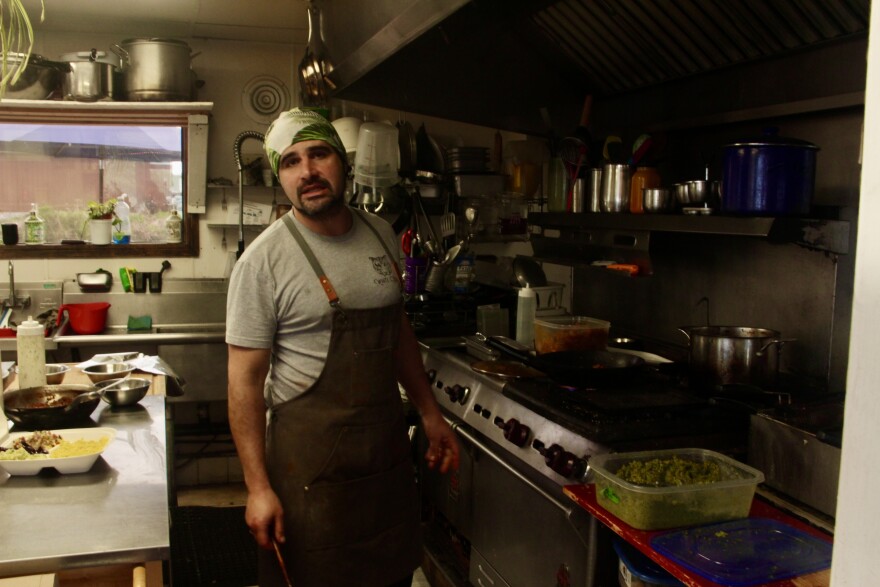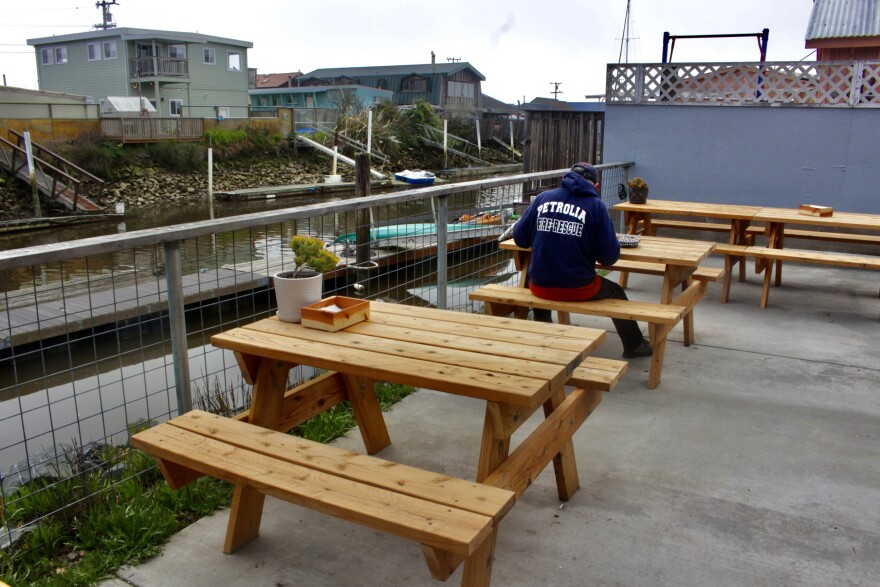This story aired in the July 16, 2025 episode of Crosscurrents.
Click the link above to listen.
Today, we have part two in a seven part series looking at sea level rise in California. From the San Diego / Tijuana Border all the way up to Humboldt Bay, we’re visiting some of the people and places that are dealing with flooding, coastal erosion, and pollution… all made worse by rising tides.
KALW’s Emergency and Disaster Preparedness reporter Wren Farrell is the lead producer on this series. He spoke with KALW's Crosscurrents host Hana Baba about the continuing series.
HANA BABA: Hi Wren.
WREN FARRELL: Hi Hana.
HANA: So, quick recap for listeners who might’ve missed part one. What was the last episode about?
WREN: So yesterday we heard from KALW’s climate reporter, Mary Catherine O'Connor, about a small community in Napa County that’s struggling to agree about what they need to do to protect their homes from rising sea levels. There are about 130 houses on a two mile road, with water surrounding them on both sides. For almost a century they’ve relied on a levee to keep the water back, but because of the way things have shaken out, every homeowner is responsible for maintaining the section of the levee that’s in front of their house. When one person doesn’t do their part, everyone’s house is at risk of flooding. Some people think there should be a community wide levee repair fund, and some think the system works just fine as it is.
HANA: Got it, so individual vs collective action.
WREN: Yeah, it’s a very classic climate change story, in my opinion, and it’s an issue that’s playing out in communities across the U.S. And probably across the world. What one person does or doesn’t do can have a profound impact on their neighbors… but some people don’t want to be told what to do.
HANA: So what’ve we got today?
WREN: Today, reporter Sydney Fishman is taking us up to Humboldt Bay, specifically to King Salmon. It’s an unincorporated community on the southern edge of Eureka. It’s a small, mostly peaceful town.
But three to four times a year “King Tides” roll in. And when those tides combine with the heavy rain, it’s not uncommon for buildings in King Salmon to flood with a foot or more of water.
Reporter Sydney Fishman looks at the impact of climate change on one local business and the surprising way the restaurant’s owner is dealing with sea level rise.
— — —
REPORTER: People in Eureka flock to the Falafelove restaurant in King Salmon partly for the view. The wood-paneled restaurant has tons of waterfront seating tucked right next to the docks.
But they’re also coming here for what might be Humboldt County’s most beloved Mediterranean food.

The owner Avishai Leibson is always in the back— frying up falafel wraps, fish, and lamb.
LEIBSON: We're just trying to serve fresh and humble food. It's pretty simple ingredients.
REPORTER: But last December, Falafelove faced a huge challenge. Three atmospheric rivers hit the North Coast while the tides were at their highest.
LEIBSON: When I signed the lease, the landlord included a little addendum saying I understood the place floods… I figured, sure, maybe there’s some water in the parking lot.
REPORTER: Leibson keeps local tide charts on hand for these kinds of situations. After he looked over the charts, he realized just how much water was about to come into his restaurant during this mid-December storm.
The morning when flooding was supposed to be at its worst, Leibson decided to head into the restaurant, grab his fisherman gear, and get to work cleaning up the water.
LEIBSON: Then I saw the water start seeping into the building. I had my Xtratufs on — I fish, so I’m used to it — but the water got all the way up to the top of my boots. At that point, there’s really nothing to do but wait for the tide to turn and the water to recede.
REPORTER: Leibson figured out how to capitalize on this daunting situation. He took out his phone and started recording.
LEIBSON: We ended up with about a foot of water inside the building. It actually turned into a great viral moment — we captured it on video with a kayaker coming in.
REPORTER: In fact, after the flooding, Leibson and his team received an outpouring of love from the Eureka community, which he wasn’t expecting.
They received hundreds of new followers on their Instagram and had help from locals in cleaning up the restaurant.
It’s worth noting that this part of Eureka is somewhat remote. There aren’t many restaurants nearby. So some customers, like regular Joe Brown, say they simply roll with the punches when the tides start rising.
BROWN: It’s us chilling and hanging out and eating whatever and watching the water. But what makes a difference is this, sitting outside on the water on the bench. So he's talked about moving to better places, but is there a better place than you could be than on the water?
REPORTER: Leibson explains that he had to spend thousands of dollars to fix the kitchen equipment that was ruined by the flooding.
LEIBSON: We’re definitely losing thousands. But it’s not in the tens of thousands — it’s not going to break me.
REPORTER: On average, Leibson’s restaurant floods about eight days a year. He says that usually the water gets about a foot high and they only have to close up shop for a few hours.
LEIBSON: So will it flood? Absolutely. Is it sustainable? Well, that depends. Sustainable to what extent? I’d say yes — to a certain degree. It’s sustainable as long as you're resilient.
REPORTER: Leibson says that back in the 1980s, the Army Corps of Engineers created dunes in the area to help reduce flooding.
But he says that Falafelove does not have flood insurance. He also says that he didn’t get any financial or other support from the county when the flooding happened. But that didn’t matter too much, because the Humboldt community had his back.
LEIBSON: We had a lot of marine biologists and fisheries biologists. The Humboldt community is so involved in so many ways. People helped — like my grower friends — that were immediately like: “Here's dehumidifiers and here's fans and dry your building down.” We got an outpouring of support, and people asked what they could do to help and how they could be of aid.
REPORTER: Most people, like homeowners, don’t have the same type of resources. King Salmon is a mostly residential neighborhood and now some homeowners are exploring ways to make their properties more resilient to flooding.
SEEMAN: Some landowners have tried modifying their homes to make them more resilient to flooding but that’s very expensive. Usually that involves raising the house up, or remodeling, so the first floor is parking or storage that’s not affected by flooding.
REPORTER: That’s Hank Seeman — the Deputy Director of Environmental Services for Humboldt County. In recent years, Humboldt County has received several grants to study how the area can adapt to flooding. It’s also working with Cal Poly Humboldt to develop adaptation strategies for these coastal neighborhoods.
SEEMAN: We're trying to understand specifically: Where's the flooding happening? What are the flow paths? Where's the water coming from? What are the consequences of that flooding? And then trying to come up with ideas that are short-term and long-term to try to help alleviate flooding, kind of more with the focus on the hazardous flooding.
REPORTER: Seeman says the county is also looking at ways to help both business owners and homeowners apply for permits to make their buildings more flood-resistant.
But, the forecast is still a bit scary.
KIDWELL: In Humboldt Bay we've got the plate tectonics that are pulling the surface down, which is essentially making the sea level rise get faster.
REPORTER: That’s Matthew Kidwell. He’s the lead meteorologist for the National Weather Service in Eureka. Kidwell says sea level rise in Humboldt Bay is happening at an alarming rate. By 2050, sea levels in Humboldt Bay are projected to rise by more than a foot — the fastest rate on the West Coast.
The message is clear: Local scientists and politicians say that coastal residents and business owners need to adapt in more tangible, concrete ways, because sea level rise isn’t slowing down.
But in true Falafelove fashion, Leibson wants to celebrate the inevitability of sea level rise. He’s even considering hosting a “King Tide” themed party at his restaurant.
LEIBSON: We’re still dreaming about hosting a King and Queen tide event here. The idea is to have people come on paddle boards and kayaks into the parking lot, maybe serve some coffee. You know, when life gives you lemons, you want to preserve them—like we do with food.




